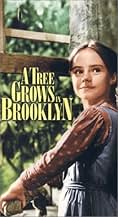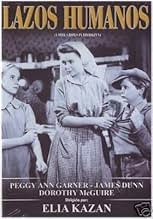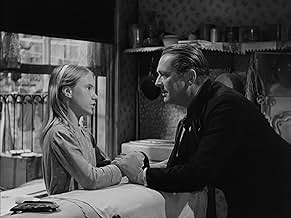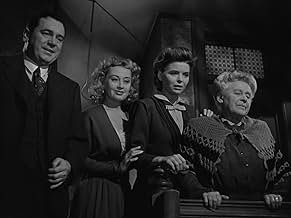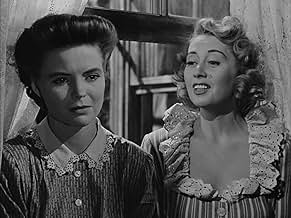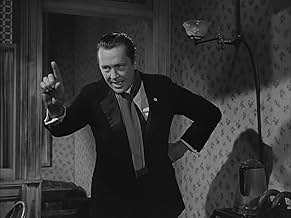Alentada por su idealista aunque poco afortunado padre, una joven brillante e imaginativa llega a la mayoría de edad en una vivienda de Brooklyn durante los primeros años del siglo XX.Alentada por su idealista aunque poco afortunado padre, una joven brillante e imaginativa llega a la mayoría de edad en una vivienda de Brooklyn durante los primeros años del siglo XX.Alentada por su idealista aunque poco afortunado padre, una joven brillante e imaginativa llega a la mayoría de edad en una vivienda de Brooklyn durante los primeros años del siglo XX.
- Dirección
- Guionistas
- Elenco
- Ganó 1 premio Óscar
- 9 premios ganados y 1 nominación en total
- Augie
- (sin créditos)
- Nurse
- (sin créditos)
- Mr. Creckenbox
- (sin créditos)
- Girl
- (sin créditos)
- Old man on second floor landing
- (sin créditos)
- Grandma Rommely
- (sin créditos)
- Cheap Charlie
- (sin créditos)
- Miss Tilford
- (sin créditos)
Opiniones destacadas
It is like the anti-"Meet Me In St. Louis" of the previous year. This American family is one of second generation Americans, descended from European immigrants, who have no particular skills and live in the tenements of Brooklyn. The central character is the daughter, Francie, who is a bit of a dreamer like her father, and in fact she adores her father. She wants to be a writer and has a great thirst for knowledge. There is a very cute exchange between herself and the local librarian when she says she is trying to read her way through the library alphabetically by author but has reached a book that is probably just too much for an eleven year old girl. The brother - hard to tell if he is a year older or younger - is very different from her, not that interested in learning, and would probably not go to school if he was not forced, but that doesn't mean he is a bad kid.
You meet the mother in the family first -Katie Nolan (Dorothy McGuire). This first scene is skillfully written, and you immediately get, before even meeting him, that Katie is always doing battle with the family budget and must scrub floors for a living because her husband is a bad provider. In short she is tired of his nonsense but feels trapped.
Then you meet the father and husband - Johnny (James Dunn). He is a singing waiter when he can find work. He has a good voice, but he has neither gotten serious about singing as a career or outright abandoned it in favor of learning some other trade. Instead he is always dreaming about his ship coming in. He is an alcoholic but not a mean one. And he is exactly the kind of guy who would sweep a girl off her feet when she is 18, but who will never pan out as far as getting serious about work and whom you will be acutely impatient with by age 30. James Dunn won an Oscar for his performance here, and ironically he actually was fired by Fox in the 1930s because of his drinking and Fox was reluctant to take him on again for this role because they did not want a repeat performance.
Katie's sister, Sissy, is played by the boisterous Joan Blondell. Sissy seems to have money - she is always well dressed. And she has just entered into a third marriage without really being sure she was divorced from the second. She has money but no children, which she wants badly. However, she has had several miscarriages. Katie has children but not enough money to really support them. So you feel like some of the undercurrents of tension between the two sisters is that each badly wants something that the other one has and feels that they take it for granted.
One of the great things about this film is that it takes time to go about the neighborhood and let you meet all of the people who live there - the barber, the local saloonkeeper (James Gleason), the sick little girl who lives downstairs, and the local beat cop. Together this weaves an interesting tapestry of atmosphere.
So this is "one year in the life of an American family", but that year is full of hard knocks and also some complete tragedies, but some good events too. It is absolutely worth watching.
Opening with an eye-view of early Brooklyn with horses pulling the food carts through cobblestone streets, trolleys passing by ringing the bell, clothes hanging out to dry over the back alley of apartment buildings on the line connected from one fire escape to another, the first half hour gives an insight look into the livelihood of the Nolan family: Katie Nolan (Dorothy McGuire), an embittered wife and mother who must scrub floors in order to support her family; Johnny (James Dunn), her happy-go-lucky husband who just can't seem to find time to earn a living but does take the time to cater to his children, particularly his "prima dona" adolescent daughter, Francie (Peggy Ann Garner); Francie finds the world a fabulous place to grow up in, and like President Abraham Lincoln, wants to learn everything about anything by reading books; Neely (Ted Donaldson), the youngest, would just rather enjoy himself playing in the streets with the other kids than going to school. While Francie and Neely are total opposites, they are typical brother and sister, having their differences but showing their devotion for one another. Their dad, Johnny, a singing waiter by profession, is a caring soul with a weakness for drinking and gambling. His wife, who feels him a failure, would discover, at his funeral the abundance of people in attendance, that anyone with as many friends as he had was not a total failure at all. Since Johnny was taken for granted by both his wife and son, Francie is one who looked up to him as someone special. Another member of their family looked upon with great fondness by the children is their beloved and fun- loving Aunt Sissy (Joan Blondell), whose past reputation doesn't go well with sister, Katie.
At 128 minutes, there's bound to be slow spots, but with those slow spots comes some great highlights: The Nolan kids visits to the local meat market telling the butcher their order for what "Momma said"; Francie reading a book on the fire escape and observing everything going on around her; Johnny singing a traditional Irish song, "Annie Laurie"; The Nolan kids obtaining a Christmas tree from a street vendor (B.S. Pully) on Christmas Eve followed by the family togetherness on Christmas Day; Aunt Sissy taking Francie to a secluded place in the school building after the girl receives her graduation gift (flowers), arranged several months ago by her father, now deceased, so she can have herself a good cry; and Officer McShane (Lloyd Nolan - excellent) nervously proposing to Widow Katie Nolan so he can provide for her and her new born baby; and one on the rooftop with Francie and Neely overseeing the city of Brooklyn, looking back with fondness to the times they had together, putting those memories behind them.
With Peggy Ann Garner being the main focus here, she deservedly won a special Academy Award for her natural performance. James Dunn (1904-1967), a veteran actor of Fox Films best known for his roles opposite Shirley Temple in the mid 1930s, makes a temporary comeback in a major motion picture that earned him a much deserved Academy Award as Best Supporting Actor of 1945. Along with Garner, Dunn was not only a natural, but born to play his role, that of Johnny Nolan. Let's not overlook Joan Blondell, another screen veteran, giving one of her best performances of her career that should have been honored an Academy Award nomination as Best Supporting Actress. Along with Dunn, Blondell's chemistry with the children is not only natural, but highly memorable.
In smaller but not entirely unimportant roles are Lloyd Nolan (Officer McShane); James Gleason (Mr. McGarrity, the neighborhood barber); John Alexander (Steve Edwards, Sissy's latest husband); Ruth Nelson (Mrs. McDonough, Francie's teacher who inspires her to become a write); and J. Farrell MacDonald (Carney, the junk man). That distinctive voice of the Christmas tree vendor belongs to B.S. Pully. And who can forget boy actor Ted Donaldson's distinctive Brooklyn accent, adding the flavor to character.
A TREE GROWS IN BROOKLYN might have been filmed at the back-lot of 20th Century- Fox, but it does have that Brooklyn flavor to it (particularly with the organ grinding score to "Rings on Her Fingers" and other popular tunes of the day. Author Betty Smith recaptures everything there is to the old New York and the characters she created, while Elia Kazan, making his directorial debut, successfully brings all this and the characters to life.
A TREE GROWS IN BROOKLYN (in reference to a tree in the back lot of the apartment) was distributed on video cassette in 1991. Other than becoming a late show favorite on commercial television from the 1960s to the 1980s, especially on Christmas Eve, it has later enjoyed frequent revivals on American Movie Classics cable channel for many years before turning up on the Fox Movie Channel and Turner Classic Movies where it premiered February 8, 2009. In spite of a 1974 television movie remake, the 1945 original remains an unsurpassed movie gem. Why? Because, "Momma said." (****)
¿Sabías que…?
- TriviaAfter being so impressed by the dailies of the film, executives at Fox wanted to re-shoot the entire movie in Technicolor, but Elia Kazan refused.
- ErroresThe portrait of General Washington in Francie's classroom was issued nationwide to public schools and buildings in 1932 to mark the bicentennial of his birth. The chronology of the story has events taking place at least 20 years earlier.
- Citas
Francie Nolan: Out the window, our tree they killed it!
Johnny Nolan aka The Brooklyn Thrush: Well, would you like at that now.
Francie Nolan: They didn't have any right to kill it did they papa!
Johnny Nolan aka The Brooklyn Thrush: Now wait a minute. They didn't kill it. Why they couldn't kill that tree.
Francie Nolan: Promise?
Johnny Nolan aka The Brooklyn Thrush: Why sure baby. Don't tell me that tree is gonna lay down and die that easily. Look at that tree. See where it's coming from. Right up outta that cement! Didn't nobody plant it. Didn't ask the cement to grow. It just couldn't help growing so much it just pushed that old cement out of the way. Now when you bust it with something like that, can't anybody help it, like... like that little ole bird up there. He didn't ask anybody could he sing and he certainly didn't take any lessons. He's so full of singing it just has to bust out someplace. Why they could cut that ole tree right down to the ground and a root would push up someplace else in the cement.
- ConexionesFeatured in Elia Kazan: A Director's Journey (1995)
- Bandas sonorasI've Got Rings on My Fingers (Mumbo Jumbo Jijjiboo J. O'Shea)
(1909) (uncredited)
Music by Maurice Scott
Performed by a calliope
Selecciones populares
- How long is A Tree Grows in Brooklyn?Con tecnología de Alexa
- What is 'A Tree Grows in Brooklyn' about?
- Is 'A Tree Grows in Brooklyn' based on a book?
- What does a 'tree' have to do with the story?
Detalles
- Fecha de lanzamiento
- País de origen
- Idioma
- También se conoce como
- A Tree Grows in Brooklyn
- Locaciones de filmación
- Productora
- Ver más créditos de la compañía en IMDbPro
- Tiempo de ejecución2 horas 9 minutos
- Color
- Relación de aspecto
- 1.37 : 1
Contribuir a esta página




